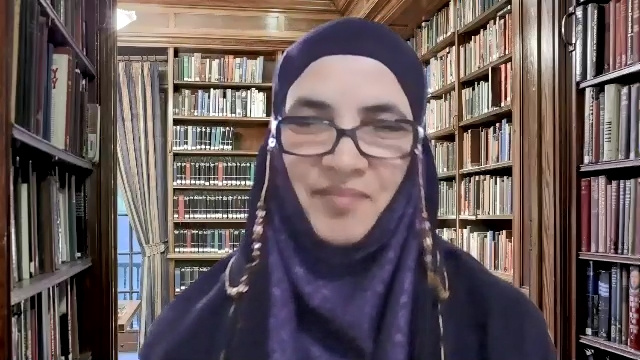A Talk between Dimitri Gutas and Nadia Maftouni about Avicenna and Suhrawardi
Dimitri Gutas is an American Arabist and Hellenist and professor emeritus of Arabic and Islamic Studies in the Department of Near Eastern Languages and Civilizations at Yale University. Nadia Maftouni is a prominent Iranian academic, philosophical author and artist, an associate professor at University of Tehran, a senior research scholar at Yale Law School, and on the board of History of Philosophy Quarterly of University of Illinois.
Maftouni: I do get to underscore your approach to Ibn Sina, which I absolutely give a preference to. It’s worth, I believe, recapping over and over.
Gutas: and I'll be glad to say a few words about the Western, my approach to the study of Avicenna which sort of is being generalized, I think I dare say. But I will explain. And the best way to start is to tell you how I came to study Ibn Sina—and call him his proper name to study Ibn Sina—and to study him in this particular way. Already when I was a student in university, I was taking a class on Islamic philosophy and we had some papers to write for something to study and work on.
And at the time, I had worked a little bit on Farabi. And I thought perhaps I should have a look at Ibn Sina. But then the prevailing approach to Ibn Sina at the time that is early 70s—all right, I'm getting really very much ahead in years; that was in the early 70s—the prevailing approach to Ibn Sina was basically that he was yes, a philosopher, but primarily he was a mystic, a sufi, and ishraqi, an illuminationist; that is what was understood to be his Hikmah Mashriqiah was the guiding of the real expression of his philosophy and so on.
So, I thought well, I was not very much interested in mysticism, in sufism. Well, I was a little bit in the early sufis especially I liked very much Bistami and of course Hallaj and all those great figures. But I was much more interested in philosophy. So, I said let me see what Ibn Sina did. And I chose as a subject for the paper I wanted to write for that course—I chose as a subject Ibn Sina's Commentary on the Anima, Finnafs of Aristo. He has a hashia on the Finnafs of Aristo was published by Badawi in the Aristo indal Arab. And it was available in print at the time. So, I thought well, let me see what Ibn Sina has to say about Aristotle's views on the soul which is a highly philosophical work. And I said how much can he make mysticism out of it. That's interesting to see exactly what Ibn Sina's approach would be.
And well, it turned out that—to cut a long story short—as I was reading, I found nothing mystical about it but extremely interesting and philosophically acute analyses of Aristotle. And I was delighted; I said well wonderful this is. And then of course I try to understand better what Ibn Sina says obviously. He said a few things but he doesn't explain all that much most of the time. So, I said well, the way to find out about this is to read some more Ibn Sina. So, I started reading the Shifa and this and that and the other. And of course, the more I read the more enchanted I was by the power of the thinking by the power of his thought by his arguments by the whole system that he was putting together in there. So then as I was trying to, then decided to edit anew this al-Hashiah fi Kitab al-Nafs.
I was trying to edit it again. But of course, in there as you know he mentions the Hikmah Mashriqiah; he mentions the Mashriqioon. He says if you want to find out more about this subject go and read what the Mashriqioon have to say. So well, who are these Mashriqioon? That’s always been a problem and again the available literature at the time said that the Mashriqioon were the Eastern, the Oriental philosophers. Again, no name; well perhaps the ancient Iranian philosophers, the pre-Aristotelian Greek philosophers; primarily what Suhrawardi has to say about some of the earlier tradition. Well, that didn't really seem very right to me. And I said I have to look around and what Ibn Sina really means with Mashriqiah. And it turns out of course he was referring to his own brand of Aristotelian philosophy as he developed it.
And of course, with Mashriqiah he only meant not Orient as the scholars of Corbin and Seyyed Hussein Nasr believe, is not the Orient; it is simply Khurasan. Mashriq just as Maqrib is west, Mashriq of course is east and most near east that is the Khurasan. And he was of course from Khurasan himself. So Hikmah Mashriqyah refers to his own brand of philosophy that he developed at a certain point. Because in many other works of his, he speaks how the philosophers from Baghdad, the Aristotelian philosophers are not saying this properly and they're making mistakes here and there. So, he corrects them. So, this is what he was talking about. So just then as I was trying to see then what he meant by this I had to read more and more Ibn Sina and find out what the whole thing was all about. So, I had to leave aside my edition of his commentary on the Anima of Aristotle and I tried to see how to read Ibn Sina and his works and that's what gave rise to my book Avicenna and the Aristotelian Tradition Introduction to Reading Avicenna's Philosophical Works. As I was trying to teach myself how to read Ibn Sina, I thought I would put it down in writing and have people read it themselves as well and the approach then it turns out is simply just read what he says don't assume that he's this or that or the other but read every work of his and try to understand it what he says precisely and to do this you have of course to be able to read all the literature that was available to him at the time which is all the translations that were available to him and of course all the other works that were written by Muslim and non-Muslim scholars before him well certainly the Baghdad Aristotelians who were not all Muslims and the
of course the kalam works etc. the theological works that were written and this is the kind of background that one needs to be able to read Ibn Sina and see what he has to say so on that basis I went ahead and I tried to understand what he says the issues that were most crucial about his mysticism or his oriental philosophy turned out not to be that and as it turns out I found out that he's a highly a logical author a rationalist author I should say who sets very great store by the rational method and especially syllogistic thinking and I figured out that one term that he was using very frequently in his analysis his logical analysis was the term hads which is as you know the ability to find the middle term of a syllogism so as he says in his autobiography when he was young and he was studying philosophy he would sit down and write in cards almost like our in a card file so to speak all the arguments that he was reading in Aristotle presumably and tried to figure out what the logistic reasoning was in there along with all the middle terms and all the syllogisms and this is how he went ahead so nowhere in his works does he say that we can have knowledge that is not
logically derived basically there are some primary notions which we simply have the awaliat which he says but these are simply the way in which our intellect works that we have and then everything else depends on the information we get from the senses so he was an empiricist in a way as I also write in one of my articles and he constructs this wonderful philosophical system putting together the different parts and analyzing it so that was as I said my approach because I did not come with any as a matter of fact I did not come with any preconceived notions about what he should be saying rather I just wanted as a matter of fact I came against the preconceived notions that he was a mystic.
Maftouni: Let me turn to a brief discussion of my paper written in honor of Professor Gutas: “Avicenna’s Influence on Suhrawardi in Form and Content.” It’s just to say a few words in honor of you. I mean it’s not supposed to be useful to you.
I’ll argue that Suhrawardi is crucially affected by Avicenna both in form and in content. As you’re all aware, people say Suhrawardi is the founder of the Illuminationist School. It doesn’t matter, believe or not believe in Illuminationist School, I’ve argued in my paper that in his nine/ten symbolic treatises, Suhrawardi fleshes out some philosophical issues of Avicenna by allegories. The number of his treatises would be nine, if you exclude the Birds and consider the Birds a Persian rendering of Avicenna’s treatise. If you include the Birds and consider the Birds a dependent treatise, the number would be ten. For me, it’s just a Persian rendering of Avicenna’s. But Suhrawardi gives the bats’ heroic role to moths (shabpareh).
Related to these treatises, I’m centering around two points: First, you find Suhrawardi a storyteller like Avicenna in the Treatise of Birds. Second, his allegorical views are Avicennian through and through. In brief, you see in Suhrawardi a storyteller who tells the story of Avicenna, even in the Red Intellect, for example. For now, I will not consider the Avicenna’s contentions, nor except in passing, those of Suhrawardi. I just hint at three issues of sense perception, emanation, and cosmology for which you see allegories as diverse as ten towers, ten graves, ten flyers, ten straps, ten wardens, five chambers versus five gates, ten old men, nine shells, eleven layers, eleven mountains, and so forth. All of these allegories allude to Avicenna’s views. That is, Suhrawrdi encrypts Avicenna’s stance by allegory, in lieu of his own illumationist views.
The first issue I focus on is sense perception. Avicenna is the first major thinker holding five interior senses vis-à-vis five exterior senses. Suhrawardi criticizes Avicenna’s stance on five interior senses, however, he indicates the faculties of ten sense perceptions in allegory. The allegories of ten sense perceptions comprise five chambers and five gates in the Treatise on Love/On the Reality of Love, ten towers in the Treatise on Towers, ten straps/ten wide straps in The Language of the Ants, ten graves in A Tale of Occidental Exile, ten flyers in The Simurgh’s Shrill Cry, and ten wardens in The Red Intellect.
Emanation is the second issue. The Peripatetic philosophers believed in ten separate intellects emanate from the First Being. The tenth one, the Active Intellect, generates the sublunary realm/ɛ. In traditional cosmology, the nine spheres and the sublunary realm/ɛ are managed by ten intellects. But in the book of Hikmah al-Ishraq Suhrawardi holds that the intellects are more than ten, twenty, and two hundred. In Alvah Emadi, he also emphasizes that there are too many intellects, quoting Quran’s verse: “None knows the armies of your Lord save Himself”. Yet in his allegorical treatises, Suhrawardi symbolizes the theory of ten intellects and nine spheres in which Avicenna believes. He briefly hints at ten intellects by ten old men in the Treatise on Towers. In The Sound of Gabriel’s Wing, ten intellects are symbolized by ten old men again. In some cases, just the tenth intellect is mentioned. In A Tale of Occidental Exile the Active Intellect is allegorized by the father.
The luminous elder, the first child of creation, and the Red Intellect are other allegories of the tenth intellect brought in the treatise of The Red Intellect. And in On the Reality of Love the tenth intellect is a young old man called Eternal Wisdom.
Cosmology is the third issue. The idea of ten Separate Intellects results in that of the nine spheres. In A Day with a Group of Sufis, Suhrawardi himself has decoded his allegories about nine spheres. At first, he mentions the theory in allegorical form. Then he explains his own allegories, corresponding to the nine and eleven spheres.
When the wayfarer said to his master, “The engraver’s craft is amazing,” said his master, “There is a well-known tale in their craft, but no one tells it fully, and no one knows the meaning of it.” “What is this tale?” asked the wayfarer. His master went through the story: “Once, an engraver had a jewel. He wanted to display his skill on it. So from it he made a round shell like a ball. Then, from the residue left in the middle of the shell he made another shell inside the first. Again, from the residue of the second he made a third, and so on until he had made nine shells.”
Sometimes Suhrawardi speaks of the eleven spheres, adding two spheres of zamharir and ether in A Day with a Group of Sufis and in The Sound of Gabriel’s Wing. In The Sound of Gabriel’s Wing the eleven spheres are allegorized by the eleven layers of a basin which the wayfarer saw in the courtyard: a basin with eleven layers. In The Red Intellect, there are eleven mountains surrounded by Mount Qaf hint at the eleven spheres. For the sake of economy, I don’t mention The Language of the Ants and On the State of Childhood. In brief, Suhrawardi elaborates philosophical issues as a storyteller. In the field of sense perception, ten interior and exterior senses are allegorized by ten towers, ten wide straps, ten graves, ten flyers, ten wardens, five chambers and five gates. In the theory of emanation, the ten Separate Intellects are allegorized by the ten old men, whereas the Active Intellect by the father, the master, and the Red Intellect. In cosmology, the spheres are symbolized by nine shells, eleven layers of a basin, eleven mountains, sons, and mills.
Ten sense perceptions, ten intellects, and nine or eleven spheres are modules of Avicenna’s philosophy. And the form of storytelling at least in Muslim philosophers originated by Avicenna. And that's it; sorry for bothering you Professor Gutas.
Gutas: No; thank you very much! I hadn't put all these ten numbers together. Well, I have not read Suhrawardi as carefully as you have. But it is very illuminating to me as well to see that this is so. No, no, perfectly fine! And there's always something to learn from everybody. So, thank you very much for that. This is really wonderful; especially the five internal senses which is real original innovation of Ibn Sina and a wonderful scientific advancement. I mean, this is after Aristotle that was the most major scientific advancement in psychology since Aristotle basically and then after that. I don't know perhaps we'd go with Freud or whatever it is, it was a very big step forward, so to speak. So, it is interesting to see that he put together with the external senses of course to get the ten. That is wonderful. Thank you very much Nadia.







Your Comment :